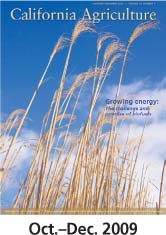All Issues
Letters: January-March 2010
Publication Information
California Agriculture 64(1):5-5.
Published January 01, 2010
PDF | Citation | Permissions
Full text
Fighting 150 million years of cell-wall evolution
Good articles on biofuels (October-December 2009) — and timely. To what extent is the research on how to break down plant cell walls fighting at least 150 million years of plant evolution that protects plants from decaying fungi and bacteria? If we were to produce a plant with a cell wall that was easy for humans to break down, would this plant not be vulnerable to attack? This plant might be difficult to grow, a fact of particular importance to tree farmers like myself. (I have managed my family's tree farm in Comptche since 1977.) It could be that humans are the neophytes here in the effort to find ways to easily grow and rot wood.
George Hollister Comptche, CA
Author Laura Bartley, UC Davis postdoctoral plant pathologist, replies:
You make an excellent and sobering point. Cell walls function as a barrier to, and present specific biochemical defenses against, pests and pathogens. In light of this, cell-wall researchers routinely subject plants with modified walls to inoculation with pathogens and at times find increased susceptibility. Modified energy crops will need to be field-tested for hardiness under diverse conditions before large-scale use. This said, we remain optimistic. Plant evolution has been limited to acting on lineage-limited combinations of genetic material. We hope that a semirational approach that combines multiple changes, such as new wall compositions along with wall-independent means for disease resistance, will allow us to both “grow and rot wood.” Other approaches may avoid this challenge. For example, one idea is to make plants that produce cell-wall degrading enzymes at the end of their life cycle.
Cal Ag subscriber goes electronic
I'm the head of a small software company, but I have a longstanding interest in agriculture. I think the farmers of California do an incredible job in producing so much food. My wife and I have been going to farmer's markets for more than 20 years. However, there's still a big gap between the knowledge and experience of most city dwellers and most farmers. I'm trying to educate myself.
I've been a print subscriber to California Agriculture for several years but I would like to switch to an electronic subscription. I've added your RSS feed so I can keep up. You might want to provide an easy way for other subscribers to switch.
Bravo, for digitizing current and all the previous issues. Too many journals, especially the more specialized ones, have not done that. You've made all that material available to everyone all over the world, including the younger generation that believes if it's not in Google it doesn't exist!
Anthony Meadow Oakland
Editor's note: Thank you, and others, for this suggestion. We have retooled the Web site to allow readers to easily (1) renew, if they wish to continue receiving the print journal, (2) go electronic or (3) request print subscriptions. Go to the Subscribe button (top bar) — and be sure you have your subscriber number (above your name on the address label).
WHAT DO YOU THINK?
The editorial staff of California Agriculture welcomes your letters, comments and suggestions. Please write to us at 6701 San Pablo Ave., 2nd floor, Oakland, CA 94608 or calag@ucop.edu . Include your full name and address. Letters may be edited for space and clarity.
Corrections:
The October-December 2009 issue contained the following errors, which were corrected online:
-
Typographical errors were corrected in figure 5 (page 175) of the review article by Bryan Jenkins et al.; the correct words are “coal” (not “goal”) and “grease” (not “grass”). For corrected figure, go to: http://calag.ucanr.edu/archive/?file=fig6304p175.jpg .
-
Page 164 included a picture of wild rice, which is not under consideration as a biofuel. The photograph was replaced with the Japonica species predominant in California rice production. Go to: http://calag.ucanr.edu/archive/?file=img6304p164.jpg .
-
The title of a review article by Charles E. Wyman and Bin Yang was changed to “Cellulosic biomass could help meet California's transportation fuel needs” (addition of the word “help;” page 185).





